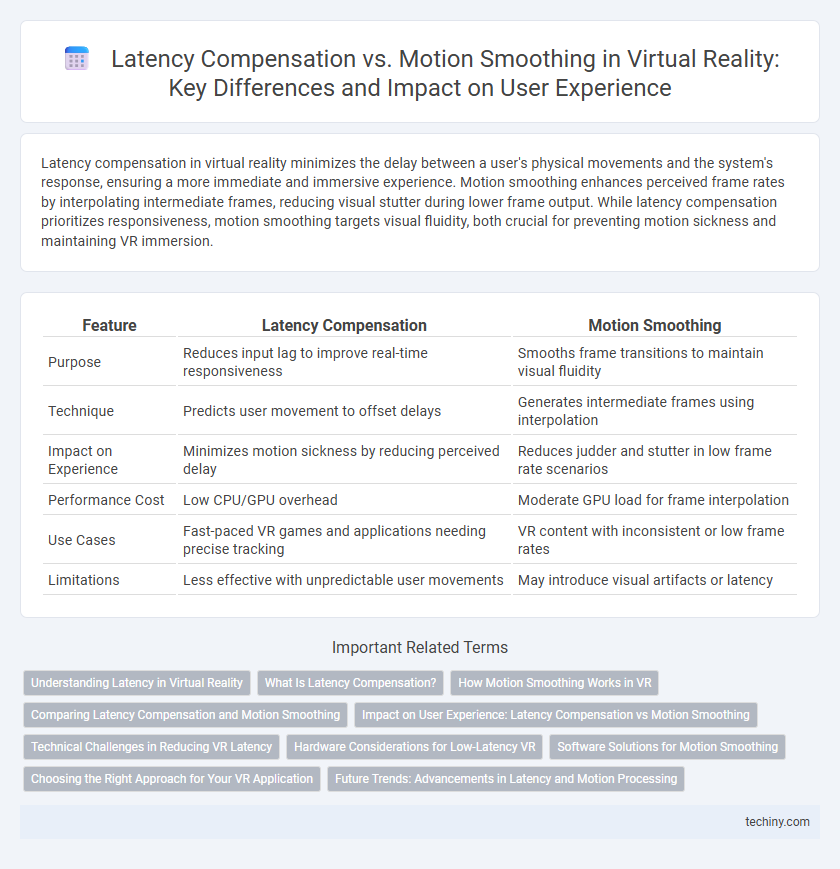Latency compensation in virtual reality minimizes the delay between a user's physical movements and the system's response, ensuring a more immediate and immersive experience. Motion smoothing enhances perceived frame rates by interpolating intermediate frames, reducing visual stutter during lower frame output. While latency compensation prioritizes responsiveness, motion smoothing targets visual fluidity, both crucial for preventing motion sickness and maintaining VR immersion.
Table of Comparison
| Feature | Latency Compensation | Motion Smoothing |
|---|---|---|
| Purpose | Reduces input lag to improve real-time responsiveness | Smooths frame transitions to maintain visual fluidity |
| Technique | Predicts user movement to offset delays | Generates intermediate frames using interpolation |
| Impact on Experience | Minimizes motion sickness by reducing perceived delay | Reduces judder and stutter in low frame rate scenarios |
| Performance Cost | Low CPU/GPU overhead | Moderate GPU load for frame interpolation |
| Use Cases | Fast-paced VR games and applications needing precise tracking | VR content with inconsistent or low frame rates |
| Limitations | Less effective with unpredictable user movements | May introduce visual artifacts or latency |
Understanding Latency in Virtual Reality
Latency in virtual reality refers to the delay between a user's physical movement and the corresponding update in the virtual environment, significantly impacting immersion and comfort. Latency compensation techniques aim to predict and minimize this delay by adjusting rendering or sensor data in real time, while motion smoothing enhances visual fluidity by interpolating frames to mask latency effects. Understanding and optimizing these methods are crucial for reducing motion sickness and delivering a seamless VR experience.
What Is Latency Compensation?
Latency compensation in virtual reality refers to techniques used to reduce the delay between a user's physical movements and the visual updates displayed in the VR headset. It helps maintain immersion by predicting head and hand positions to minimize motion-to-photon latency, ensuring smoother and more responsive experiences. Effective latency compensation improves user comfort and reduces motion sickness compared to relying solely on motion smoothing algorithms.
How Motion Smoothing Works in VR
Motion smoothing in VR generates intermediate frames by predicting head and controller movements to reduce perceived latency and maintain visual continuity. This technique analyzes past tracking data to extrapolate future positions, effectively increasing frame rates when the system struggles to render native frames in time. By interpolating frames, motion smoothing minimizes judder and preserves immersion, enhancing the overall virtual experience despite hardware limitations.
Comparing Latency Compensation and Motion Smoothing
Latency compensation minimizes the delay between a user's motion and the corresponding visual update by predicting head or controller movement, ensuring a more immediate and natural VR experience. Motion smoothing generates intermediate frames by interpolating between rendered frames to maintain fluid visuals when frame rates drop, reducing motion blur and judder. Comparing these techniques reveals that latency compensation targets responsiveness and accuracy in tracking, while motion smoothing focuses on maintaining visual continuity during performance inconsistencies.
Impact on User Experience: Latency Compensation vs Motion Smoothing
Latency compensation minimizes the delay between user movements and visual updates, reducing motion sickness and enhancing immersion in virtual reality environments. Motion smoothing interpolates frames to maintain a consistent frame rate, preventing judder and improving visual fluidity during performance drops. Combining both techniques optimizes user experience by ensuring responsive interactions and smooth visual transitions, crucial for maintaining presence and comfort in VR.
Technical Challenges in Reducing VR Latency
Reducing VR latency involves overcoming technical challenges such as sensor signal delay and rendering bottlenecks, which directly affect user immersion and comfort. Latency compensation techniques predict user movements to minimize perceived delay, while motion smoothing algorithms interpolate frames to maintain visual fluidity despite hardware limitations. Balancing accurate prediction models with computational efficiency remains critical to optimizing VR experiences and preventing motion sickness.
Hardware Considerations for Low-Latency VR
Latency compensation in VR hardware focuses on reducing input-to-display delay through high-performance sensors and fast-processing units, ensuring real-time responsiveness critical for immersive experiences. Motion smoothing leverages GPU optimization and frame interpolation techniques to maintain fluid visuals despite hardware limitations, minimizing perceived jitter. Effective low-latency VR systems balance high refresh rates, advanced tracking algorithms, and efficient rendering pipelines to optimize hardware performance and reduce motion-to-photon latency.
Software Solutions for Motion Smoothing
Software solutions for motion smoothing in virtual reality utilize predictive algorithms to reduce perceived latency and enhance frame rates, improving visual fluidity and immersion. Techniques like asynchronous reprojection and space warp dynamically generate intermediate frames, compensating for hardware limitations and irregular motion tracking. Implementing these advanced motion smoothing methods minimizes motion sickness and maintains rendering performance without significant hardware upgrades.
Choosing the Right Approach for Your VR Application
Latency compensation directly reduces the lag between user input and visual response by predicting movements, enhancing realism in fast-paced VR environments. Motion smoothing interpolates frames to create a more fluid experience by filling gaps caused by dropped frames, which works well with lower-end hardware or less intensive applications. Selecting the appropriate technique depends on your VR application's performance demands and hardware capabilities, balancing responsiveness and visual continuity for optimal user immersion.
Future Trends: Advancements in Latency and Motion Processing
Future trends in virtual reality emphasize advancements in latency compensation through predictive algorithms that anticipate user movements, reducing perceived delays. Motion smoothing techniques are evolving to incorporate AI-driven interpolation, offering more natural and immersive experiences by minimizing motion blur and judder. Combined improvements in sensor accuracy and processing speed promise a seamless integration of latency reduction and motion smoothing, enhancing overall VR fidelity and comfort.
Latency compensation vs Motion smoothing Infographic

 techiny.com
techiny.com